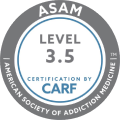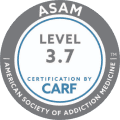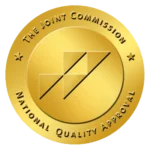Children quickly learn that medicines can help them feel better. Though medications can be hazardous, this is often forgotten as the positive effects are felt instead of the adverse side effects. Adderall is one of those medicines that have many benefits to help those struggling with attention difficulties, but it is also a medication that has a high risk of addiction.
Understanding Adderall
Adderall is a combination of two medications used to help change the impulses of the brain. Amphetamine and dextroamphetamine work on the central nervous system to improve how the body responds to certain stimuli. Adderall stimulates the brain to accept and make more dopamine, which is a feel-good hormone that can give a person a “high” or feelings of euphoria.
Adderall has a longer half-life than most drugs. The half-life is a length of time that passes before one half of the medicine has been used by your body. Some medicines work very quickly and are gone in just a few minutes or hours; Adderall’s half-life is 10 hours long. The effects are not usually felt for 10 hours, and the dosage peaks in about four to six hours.
Like all medications, Adderall has many side effects that must be considered before taking this medication. Difficulty sleeping, dry mouth, increased anxiety, headaches, irritability and anxiety are just some of the potential side effects.
Substance Use and Addiction
One specific side effect of drug use that can be extremely dangerous is addiction. Because of the feel-good effect of the medicine, it can make a person’s brain dependent on having the extra dopamine to function normally. The mind can become immune to small doses and needs ever-increasing doses to feel good again. This pattern can create an addiction.
Addiction is a condition in which a person engages in use of a substance or in a behavior for which the rewarding effects provide a compelling incentive to repeatedly pursue the behavior despite detrimental consequences.
Typically, the brain is rewarded with dopamine after the person has participated in a fun activity or accomplished something. Activities and accomplishments can be things such as having sex, getting a good grade in school, receiving a promotion at work, riding a roller coaster or even eating a delicious piece of chocolate cake. The brain interprets the signals of motivation and reward. Instead of positive reinforcement from doing an excellent job at school, for example, the body realizes that a little pill produced the same reward without all the work.
The brain is not a fool; if such an excellent reward can come from taking a pill versus hours of studying for a test, then the act of taking the pill can quickly become addictive. The brain’s executive functions are affected, and a person may not even be aware of the signals that the brain is receiving. They are just following the impulses and feelings to continue receiving the positive feedback from the brain.
Drug Abuser Characteristics
The characteristics in a person who is a drug abuser can include:
- Displaying unusual behaviors
- Having a demanding personality
- Having a vast knowledge of medications
- Being moody and irritable
- Missing diagnostic appointments
- Having suicidal thoughts
- Displaying skin-marking tracks and lesions
- Using threatening tones
- Being allergic to multiple non-narcotic pain medicines
However, Adderall abuse drug abusers tend not to fit the traditional drug-seeking mold. Adderall addiction is one that students and career-focused people face. These are highly driven and focused people; they can be young corporate executives, medical students or law students who want to get good grades. Individuals who are abusing Adderall may suddenly start experiencing symptoms of ADHD, doctor shopping in areas far from home or using different pharmacies to fill prescriptions. Borrowing money and maxing out credit cards for unnecessary purchases or becoming very secretive in actions can also be indicators of Adderall addiction.
Other people may be suddenly slovenly in their appearance where once they were smart dressers. Physical withdrawal symptoms can occur if the drugs cannot be obtained in a suitable timeframe. Lastly, they can become very aggressive and irritable, and they may experience psychosis and personality changes that can lead to secondary drug use and traditional drug-seeking behaviors.
Symptoms of Adderall Withdrawal
Because of the way Adderall can affect the brain, if you take the medicine for a long time, your body stops making dopamine for itself. Therefore, you can become dependent on the medication. If you suddenly decide to discontinue the drug, then withdrawal symptoms can occur.
The length and severity of the symptoms will vary for each person; however, the longer that someone is on the drug and the higher their doses have been, the more difficult the symptoms can be.
Adderall Withdrawal symptoms can include
- Strong feelings of depression
- Exhaustion
- Having trouble thinking
- Nausea and vomiting
- Being unable to perform normal social activities
- Shaking and trembling
- Increased hunger
- Anxiety
- Irritation
- Sleeping for long periods of time
- Having vivid dreams
- Having suicidal thoughts
Typically, the most intense symptoms happen during the first few days after stopping Adderall; however, due to its long half-life, it can take a few weeks for the medication to clear the body completely. Some withdrawal symptoms, such as increased appetite, may take many months to resolve completely.
Should Recovery Happen at Home?
Recovery varies for each person; you should discuss with your doctor the pros and cons of detoxing from an Adderall addiction at home or at a medical detoxification facility. Successful recovery depends significantly on your stability, the safety of your environment and the positive resources that you have.
For those who have had failed recovery attempts at home in the past, it is not advised that they try it again without help. Also, those who have been on the medication for a long period can have more severe symptoms and may require hospitalization.
Ways to Improve Recovery
Substance use recovery begins with a new mindset. It is not just stopping the drugs and letting your life get back to normal; it is choosing to create a new life where you make positive choices that make it easier not to use substances again. Recovery is being aware of the factors that drove you to use the drug and learning how to overcome them, which takes a new way of living. Old ways of thinking and habits will keep you stuck in a pattern of Adderall addiction and withdrawal.
Awareness of Activities
All high-risk situations cannot be avoided by just eating something or getting some sleep, but these are good starts. Other things to be aware of during your recovery are the people, places and things that remind you of substance use. It is good to stop and think about who you were with when you were taking the drugs. Was there a specific group of people who encouraged you to take substances or attend parties where the drugs were sold?
Places and things can also remind you of where you got the drugs and the things that you did while you were on them. While you can’t just avoid going out at all, you can choose to stop visiting specific bars and hangouts and patronizing events where you know substance use occurs. It can be helpful to stop and make a specific list of places and times that you should avoid, which could help you prevent future relapse. Just having a general idea of where to go is not sufficient; you need to write it down to help the brain recognize that these places are not suitable for your healing.
Relaxation
The reason that you probably starting use drugs was to escape the tension that work or school was giving you in order to succeed. This need for gratification and relaxation that the drugs brought was teaching your mind’s reward center. However, relaxation has to be relearned. No more should the brain and the body rely upon substance use to gain the positive dopamine effect: It has to be taught to do it on its own.
Ways to Relax
First of all, it is important to tell yourself that relaxation is possible without drugs and alcohol. Not only is it possible, but it is essential for you to go through recovery and stay drug-free.
Relaxation can come in the form of listening to calming music and meditating. Some people really like doing yoga and breathing work. These provide a calming influence for the mind, and they give the excited brain something to focus on instead of focusing on turning toward a pill. The brains of some people are wired and excitable; they say that there is a continual chatter going on. Turning down the chatter can be difficult, but learning to do simple activities will begin to decrease the volume.
Other helpful activities can include going on gentle walks, swimming, reading a book or knitting. All of these involve various parts of the brain, making the mind active while helping provide the positive dopamine feedback that the brain wants so as to feel good again.
Starting Recovery
Adderall is a drug that works on the feel-good part of the brain and can quickly become addictive over long-term use. Without realizing what is happening, the body can physically become dependent on the drug and produce drug-seeking behaviors in a person. Stopping the medication should be done under the supervision of a doctor due to the risk of withdrawal symptoms. Relapses can occur if a person does not have adequate help or resources to get through this challenging time. To help your recovery, you need to know the triggering factors that can lead to you craving the substances again. Relaxation, exercise and cognitive behavioral therapy are all excellent ways to help you be completely free of the drug and start making a new life for yourself. You cannot go back to an old normal, but you can create a new life for yourself that is drug-free.






